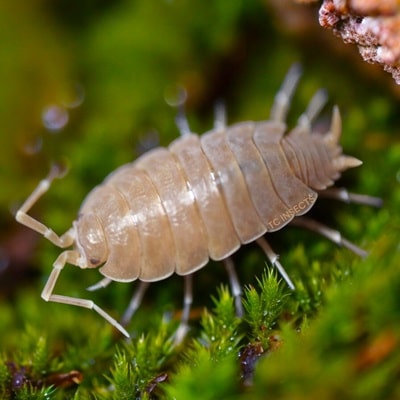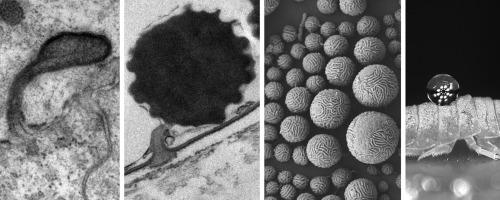Porcellionides pruinosus: Difference between revisions
No edit summary |
No edit summary |
||
| (46 intermediate revisions by the same user not shown) | |||
| Line 1: | Line 1: | ||
''[[ | ''[[Porcellionides pruinosus]]'', also commonly referred to as the Powder Blue Isopod, or Powder White Isopod is a species of [[isopods]]. It is referred to as this due to its blueish-gray powdered coloration on the carapace. [[#2.|[2]]] | ||
[[File: | |||
[[File:Isopoddd.jpg|thumb|400px|right|Close up photo of Porcellionides pruinosus]] | |||
==Taxonomy== | ==Taxonomy== | ||
'''Kingdom:''' Animalia | '''Kingdom:''' Animalia | ||
'''Phylum:''' | '''Phylum:''' Arthropoda | ||
'''Class:''' | '''Class:''' Malacostraca | ||
'''Order:''' | '''Order:''' Isopoda | ||
'''Family:''' | '''Family:''' Porcellionidae | ||
'''Genus:''' | '''Genus:''' Porcellionides | ||
==Overview== | ==Overview== | ||
[[File: | Porcellionides pruinosus is a species of terrestrial isopod in the family Porcellionidae. The species is easily distinguished due to its powdery appearance. P. pruinosus typically measures around 5-12 mm in length, and appear grey-blueish in color with a powdery appearance. This powdery appearance plays a role in water management and also aids in predator avoidance. The "powder" on P. pruinosus allows for the species to increase their [[hydrophobicity]], making them more resistant to water loss. This gives P. pruinosus an advantage in moist environments, in which it is commonly found. [[#3.|[3]]] A study from "ScienceDirect" shows that these minute spheres on P. pruinosus surface are largely organic. These spheres contain glycoproteins and polysaccharides, which are deposited early in the premolt stage of the molt cycle. [[#4.|[4]]] | ||
[[File:blueispod.jpg|thumb|500px|left|Microscopic photo showing the hydrophobicity of P. pruinosus [[#4.|[4]]]] | |||
==Feeding== | |||
For P. pruinosus to have proper nutrition, it requires it to have a diverse diet consisting of decaying plant matter, vegetables, and calcium-rich foods like eggshells or calcium bones. For growth and reproduction, P. pruinosus requires the availability of rotting wood, biodegradables, and leaf litter. As an isopod and as a detritovore, P. pruinosus is an important decomposer that has an important role in breaking down dead [[Organic Matter|organic matter]] in order to return nutrients to the [[soil]]. [[#1.|[1]]] | |||
==Habitat== | ==Habitat== | ||
P. pruinosus tends to thrive in moist environments such as under logs, stones, and leaf litter. They also tend to be found in agricultural areas, gardens, and greenhouses. This species of isopod can be found in different parts of the world, but mostly in temperate, subtropical, and tropical regions. They are a very adaptable species that can thrive in a multitude of environments. P. pruinosus is a nocturnal species that is more active during the night as it prefers damp conditions to avoid desiccation. In rare occurrences when they are disturbed they will flee to find cover, unlike other isopods that may roll into a ball. [[#3.|[3]]] | |||
==References== | ==References== | ||
<references /> | <references /> | ||
1. Porcellionides pruinosus “powder orange” isopods free shipping. The Bio Dude. (n.d.). https://www.thebiodude.com/products/porcellionides-pruinosus-powder-orange-isopods#:~:text=Their%20Role%20in%20a%20Bioactive,dead%20plants%20and%20animal%20waste. | |||
2. Abney, C. (2024, July 29). Porcellionides pruinosus “Powder blue isopods”: Care guide. Bantam.earth. https://bantam.earth/porcellionides-pruinosus-powder-blue-isopods/#:~:text=Powder%20Blue%20Isopods%20are%20a,with%20white%20and%20brown%20spots | |||
3. Isopods : Powder blue (porcellionides pruinosus) (10 ct). Wabash River Reptiles and Aquatics. (2025, April 28). https://wabashriverreptiles.com/product/isopods-powder-blue-porcellionides-pruinosus-10-ct/?v=0b3b97fa6688 | |||
4. Miloš Vittori, (2020, July 5). The origin of microscopic spheres on the exoskeleton of the woodlouse porcellionides pruinosus and their effect on its hydrophobicity. [[Arthropod]] Structure & Development. https://www.sciencedirect.com/science/article/pii/S1467803920300918#:~:text=The%20dorsal%20surface%20of%20the,hydrophobicity%20of%20the%20cuticular%20surface. | |||
Latest revision as of 14:06, 2 May 2025
Porcellionides pruinosus, also commonly referred to as the Powder Blue Isopod, or Powder White Isopod is a species of isopods. It is referred to as this due to its blueish-gray powdered coloration on the carapace. [2]

Taxonomy
Kingdom: Animalia
Phylum: Arthropoda
Class: Malacostraca
Order: Isopoda
Family: Porcellionidae
Genus: Porcellionides
Overview
Porcellionides pruinosus is a species of terrestrial isopod in the family Porcellionidae. The species is easily distinguished due to its powdery appearance. P. pruinosus typically measures around 5-12 mm in length, and appear grey-blueish in color with a powdery appearance. This powdery appearance plays a role in water management and also aids in predator avoidance. The "powder" on P. pruinosus allows for the species to increase their hydrophobicity, making them more resistant to water loss. This gives P. pruinosus an advantage in moist environments, in which it is commonly found. [3] A study from "ScienceDirect" shows that these minute spheres on P. pruinosus surface are largely organic. These spheres contain glycoproteins and polysaccharides, which are deposited early in the premolt stage of the molt cycle. [4]

Feeding
For P. pruinosus to have proper nutrition, it requires it to have a diverse diet consisting of decaying plant matter, vegetables, and calcium-rich foods like eggshells or calcium bones. For growth and reproduction, P. pruinosus requires the availability of rotting wood, biodegradables, and leaf litter. As an isopod and as a detritovore, P. pruinosus is an important decomposer that has an important role in breaking down dead organic matter in order to return nutrients to the soil. [1]
Habitat
P. pruinosus tends to thrive in moist environments such as under logs, stones, and leaf litter. They also tend to be found in agricultural areas, gardens, and greenhouses. This species of isopod can be found in different parts of the world, but mostly in temperate, subtropical, and tropical regions. They are a very adaptable species that can thrive in a multitude of environments. P. pruinosus is a nocturnal species that is more active during the night as it prefers damp conditions to avoid desiccation. In rare occurrences when they are disturbed they will flee to find cover, unlike other isopods that may roll into a ball. [3]
References
1. Porcellionides pruinosus “powder orange” isopods free shipping. The Bio Dude. (n.d.). https://www.thebiodude.com/products/porcellionides-pruinosus-powder-orange-isopods#:~:text=Their%20Role%20in%20a%20Bioactive,dead%20plants%20and%20animal%20waste.
2. Abney, C. (2024, July 29). Porcellionides pruinosus “Powder blue isopods”: Care guide. Bantam.earth. https://bantam.earth/porcellionides-pruinosus-powder-blue-isopods/#:~:text=Powder%20Blue%20Isopods%20are%20a,with%20white%20and%20brown%20spots
3. Isopods : Powder blue (porcellionides pruinosus) (10 ct). Wabash River Reptiles and Aquatics. (2025, April 28). https://wabashriverreptiles.com/product/isopods-powder-blue-porcellionides-pruinosus-10-ct/?v=0b3b97fa6688
4. Miloš Vittori, (2020, July 5). The origin of microscopic spheres on the exoskeleton of the woodlouse porcellionides pruinosus and their effect on its hydrophobicity. Arthropod Structure & Development. https://www.sciencedirect.com/science/article/pii/S1467803920300918#:~:text=The%20dorsal%20surface%20of%20the,hydrophobicity%20of%20the%20cuticular%20surface.